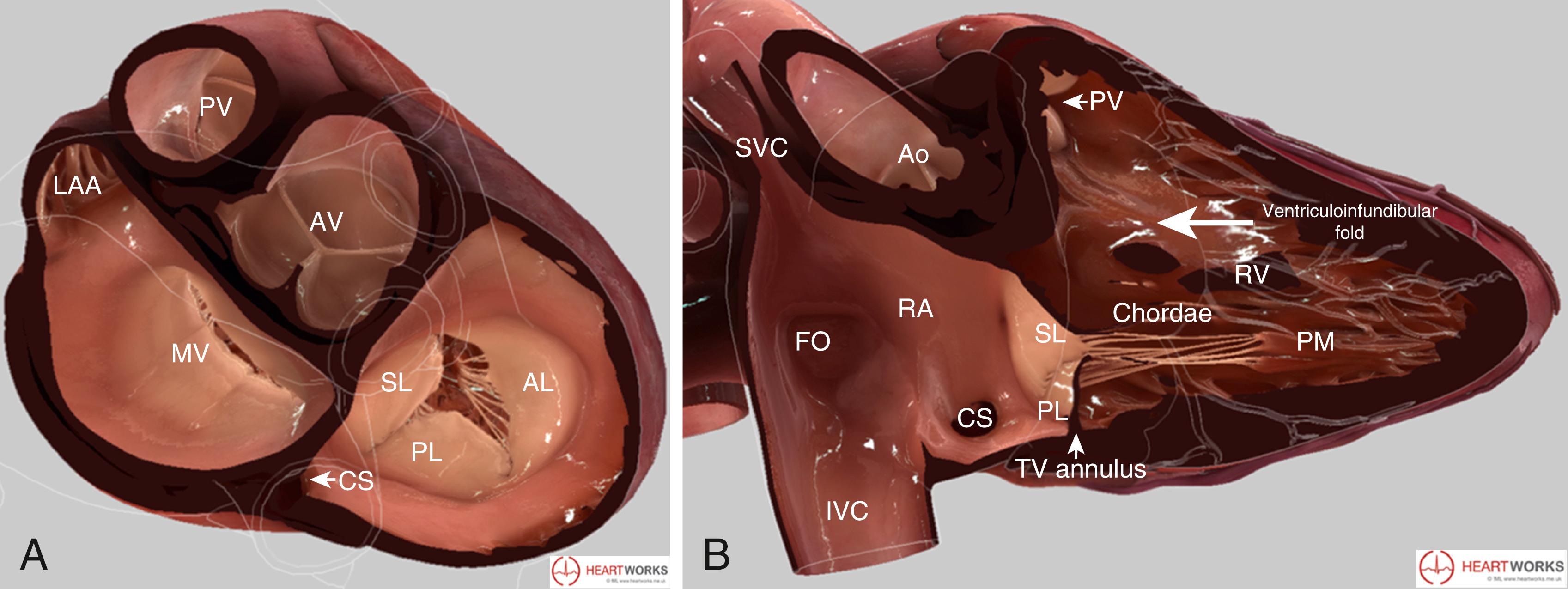Physical Address
304 North Cardinal St.
Dorchester Center, MA 02124
The tricuspid valve (TV) is the largest of the four cardiac valves, with a normal valve area of 7 to 9 cm 2 . The TV lies between the right atrium and the right ventricle and is placed in a more apical position than the mitral valve. The TV functional anatomy can be divided into four components: the leaflets, annulus (with attached right atrium and ventricle), papillary muscles, and chordae tendineae ( Fig. 101.1 ).

The number of TV leaflets is highly variable, with the trileaflet valve being the most common configuration. , Typically, the three leaflets are referred to as the septal, anterior, and posterior leaflets (see Fig. 101.1A ). Tricuspid leaflets are significantly different in circumferential and radial size. The anterior leaflet is the longest in the radial direction with the largest area and the greatest motion. The posterior leaflet is the shortest circumferentially and may have multiple scallops. It may not be clearly separated from the anterior leaflet in approximately 10% of patients. The septal leaflet is the shortest in the radial direction and is the least mobile. It is attached to the tricuspid annulus directly above the interventricular septum, 10 mm or less apically to the septal insertion of the anterior mitral leaflet. It has many third-order chordae that may be attached directly to the septum. The commissure between the septal and posterior leaflets is usually located near the entrance of the coronary sinus to the right atrium. The commissure between the septal and anterior leaflets is the longest and is adjacent to the noncoronary sinus of Valsalva of the aortic root and 3 to 5 mm anterior to the atrioventricular node. 1 Coaptation of the TV is located at the level of the annulus or just below it with a coaptation length of 5 to 10 mm, allowing some dilatation of the annulus before malcoaptation occurs. The TV is separated from the pulmonary valve by the ventriculoinfundibular fold (see Fig. 101.1B ).
The tricuspid annulus is typically triangular or D-shaped and nonplanar with two distinct segments: a larger C-shaped segment that corresponds to the free wall of the right atrium and right ventricle and a shorter, relatively straight segment that corresponds to the ventricular septum. In addition, the tricuspid annulus is saddle shaped with the anterior and posterior aspects displaced toward the right atrium. This saddle shape becomes progressively more circular and flatter with worsening of secondary tricuspid regurgitation. The tricuspid annulus lies closer (≤1 cm) to the apex than the mitral annulus. The tricuspid annulus plane is nearly vertical and about 45° from the sagittal plane and is superiorly (atrially) displaced in the anteroseptal portion and inferiorly (apically) displaced in the posteroseptal portion. Unlike the mitral valve, there is no fibrous continuity with the corresponding semilunar valve. , There appears to be very little fibrous tissue or collagen in the tricuspid annulus; rather, the right ventricular (RV) free wall segment is composed of epicardium and endocardium, with the coronary artery and veins surrounded by adipose tissue in the atrioventricular groove. In some hearts, the base of the TV consists entirely of atrial tissue. The tricuspid annulus is dynamic and can change up to approximately 30% in its area during the cardiac cycle. Normal tricuspid annular circumference and area are 12 ± 2 cm and 11 ± 2 cm 2 , respectively, with an increase in annular area during atrial systole and late systole or early diastole. ,
Become a Clinical Tree membership for Full access and enjoy Unlimited articles
If you are a member. Log in here